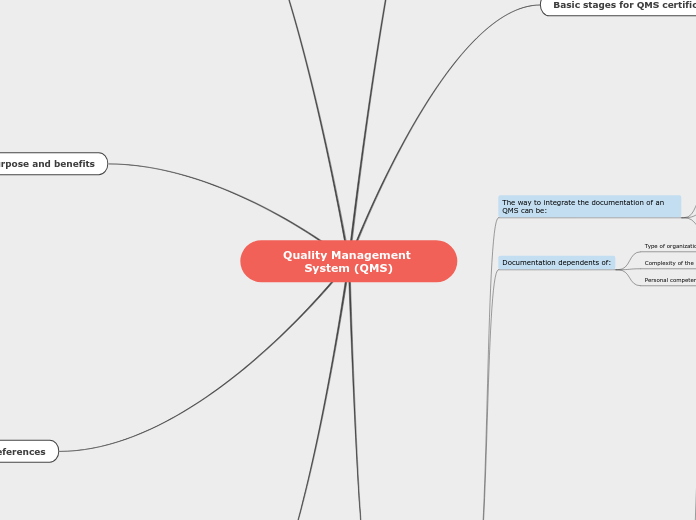Quality Management System (QMS)
Quality management
Define as:
It comprises all activities that are required to plan for quality in an organization and the activities to satisty quality objectives.
It has four elements
Quality planning
Are the activities that are performed to establish quality objetivesn identify quality requirements, plan for a QMS and plan for process execution.
Quality control
Activities to fulfill requirements for quality. It focuses on the product.
Quality assurance
Is comprises all the planned and systematic activities implemented within the quality system that can be demostrated to provide confidence that a product or service will fulfill requirements quality.
Quality improvement
Enhancement in the effectiveness and efficiency of process and enhacement in the extent to which a product satisfies applicable requirements. It includes The Deming cycle (Plan, Do, Check and Act).
Basic stages for QMS certification
In includes:
Request
It´s a kind of contract where specifies size company, the company scope and the specific time to certificate.
Documentation review
The main document that a the organization review is the quality manual in order to know a general point of view of the company or organization.
Previous evaluation
It´s a first visit to the company installations with the objective to know how much well-prepared the company is. No all companies need a previous evaluation.
Evaluation
It is determined when quality system documentation agrees to norm requirements. Two or three auditors stay in installation for two or five days, but the audit time depends of comañy size.
Certification
There are three results:
Approval
It agrees with all the requirements.
Provisional approval
It agrees with almost all the requirements, they give you time to make need changes.
Disapproval
When it disagrees with the requirements, the quality system documentation is not present in the compañy.
Supervision
Certifications have a validity time. when this time is about to run out, auditors must go back to the compañy to verify if it still agrees with the requirements.
Documentation
The way to integrate the documentation of an QMS can be:
Own organization procedures itself.
Structure of the standard norm used.
A mix of them.
Documentation dependents of:
Type of organization and its activities.
Complexity of the processes.
Personal competence.
What kind of documentation can I find in the QMS?
Quality policies.
It tells the global intation of an organization made by high direction. it relates to an organization or company´s mission and vision.
Its principles are:
Customer focus.
Leadership.
Commitment to people.
Process focus.
Continuous improvement.
Decision making
Relation management.
Quality manual
It´s a document that specifies the QMS. The manual adjusts to the complexity of the organization.
The content of the quality manual is:
Organization for quality.
Quality function planning.
Project and design control
Relationship with providers.
Process control.
Final control.
Special process
Handling, storage and dispatch.
Service and assistance.
Non-conforming materials.
Quality cost.
QMS audits.
Note: no all the companies have the same content.
Document procedures
It´s the document tha show you the way of carrying out a set of systematized activities with start and end dates.
Work instructions
Those are detailed description of how to perform and document a task. It describes the
material, equipment and documentation used
A work instruction can be:
Written detailed description.
Flowcharts.
Templates and Notes.
Drawings.
Videos.
Check lists.
Forms and records
Used to write down the results.
Quality plans
Specification of the procedures and associated resources to apply. It relates to strategic planning.
Specification
It´s the document stipulating requirements.
Can be relate to:
Activities
Like: procedure, process and test specification.
Products
Like: product specification and performance.
External documents
Those documents that contain information related to products and services contracted externally. It also includes new laws and norms established by the nation.
Definition
It is a kind of management system to lead and control an organization regarding quality.
Purpose and benefits
To show the QMS´s structure.
Groups information and their functions.
To show the compromise of the high direction with quality.
To help employees to know what de need to do inside of an organization
To ease the understanding between employees and direction.
To keep a base of expectations work.
To declare activities.
To generate records of achieving goals.
Database of employees information.
To maintain order and balance.
Operation coherence.
To work in a continuous improvement process.
To provide customer confidence.
Suppliers requirements.
To establish a way to audit the QMS.
References
ISO 9000:2005
ISO 10013
Vivek Nanda (2005). Quality management system handbook for product development companies. A CRC press book.
Peach, Robert W. (1999). Manual de ISO 9000. Distrito Federal, México. Editorial: McGraw-Hill Interamericana editores.
Pola Maseda, Ángel (1988). Gestión de la calidad. Barcelona, España. Editorial: Marcombo Boixareu Editores.
Información
Where can I store the information
Paper
Electronic media
Advantages:
Available at all times.
Changes and accesses are faster and controlled.
We can print any document whatever we want.
We can access to a document wherever we want.
Deleting a document is easier.
Reduces pollutants.
